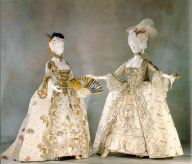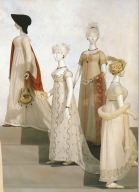 Opening Night
Opening Night
After 1789, fashion, including footwear, changed dramatically and, as
in the previous centuries,
was adapted for use in the ballet. Jacques-Louis David, principle artist
of the French Revolution, the new
Republic and eventually the Napoleonic Empire,
was asked to design a new style of clothing that would reflect the values
of liberté,
egalité, and fraternité (Lee
1999). Drawing
on the Neoclassical themes and subjects of his paintings, he looked to
the
fashions
of ancient Greece and Rome, which called up the republican values of post-Revolutionary
France.
Women began to don dresses modeled after ancient tunics with high waistlines
(the now recognized “empire waist”) and long, draping skirts.
The cut of these new fashions for women drew attention to the breasts and
the legs, (unlike fashions in
the previous century, which focused on the waistline and the hips). In
fact, looking at these
dresses
in
the previous century, which focused on the waistline and the hips). In
fact, looking at these
dresses , one can see how the female body would have appeared
to be comprised of little else. As well, the fabrics used to make these
dresses changed
from multiple layers of weighty material to lighter, draping textiles,
lending the skirt a columnar line. These fabrics not only flowed and
fluttered, giving the impression of weightlessness, but were also slightly
translucent, revealing the outline of the legs. Silk crêpe, cotton
gauze and, in particular, muslin became fashionable in the nineteenth century
for their qualities of lightness and airiness (Starobinski
et al. 1990).
, one can see how the female body would have appeared
to be comprised of little else. As well, the fabrics used to make these
dresses changed
from multiple layers of weighty material to lighter, draping textiles,
lending the skirt a columnar line. These fabrics not only flowed and
fluttered, giving the impression of weightlessness, but were also slightly
translucent, revealing the outline of the legs. Silk crêpe, cotton
gauze and, in particular, muslin became fashionable in the nineteenth century
for their qualities of lightness and airiness (Starobinski
et al. 1990).